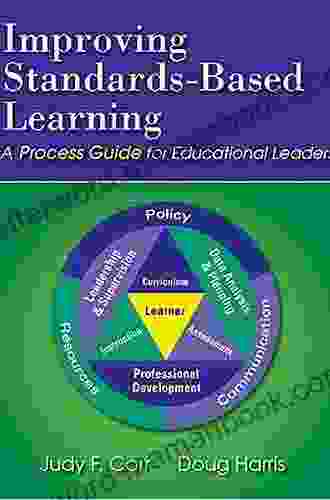A Comprehensive Process Guide for Educational Leaders: Navigating Challenges and Driving Success

Educational leaders play a pivotal role in shaping the future of education and fostering student success. However, they often face a multitude of challenges that can hinder their ability to achieve their goals. This comprehensive process guide provides educational leaders with a step-by-step approach to addressing these challenges and driving success in their schools, districts, or other educational institutions.
5 out of 5
| Language | : | English |
| File size | : | 8954 KB |
| Text-to-Speech | : | Enabled |
| Enhanced typesetting | : | Enabled |
| Word Wise | : | Enabled |
| Print length | : | 304 pages |
| Screen Reader | : | Supported |
| X-Ray for textbooks | : | Enabled |
Section 1: Strategic Planning
Effective strategic planning is the foundation for educational success. This section provides a structured framework for developing and implementing a plan that aligns with the institution's mission, vision, and values.
- Conduct a needs assessment: Identify the challenges and opportunities facing the institution through stakeholder surveys, data analysis, and environmental scans.
- Develop a vision statement: Articulate a clear and compelling statement that describes the institution's desired future state.
- Set strategic goals: Establish specific, measurable, attainable, relevant, and time-bound (SMART) goals that support the vision statement.
- Create a strategic plan: Outline the steps, resources, and timelines required to achieve the strategic goals.
- Implement and monitor the plan: Regularly track progress, make necessary adjustments, and ensure accountability.
Section 2: Organizational Alignment
Once a strategic plan is in place, it is crucial to ensure that the entire organization is aligned with and working towards its goals. This section provides strategies for creating a cohesive and collaborative work environment.
- Communicate the strategic plan: Share the plan with all stakeholders and ensure they understand their roles and responsibilities.
- Build a professional learning community: Create opportunities for staff to share knowledge, collaborate on projects, and grow professionally.
- Establish clear expectations: Define performance standards and provide feedback to help staff reach their goals.
- Reward and recognize success: Celebrate accomplishments and recognize staff contributions to maintain motivation and engagement.
- Foster a positive and supportive culture: Promote collaboration, respect, and trust among staff and students.
Section 3: Stakeholder Engagement
Engaging stakeholders is essential for building support, gaining feedback, and ensuring the success of any educational initiative. This section provides techniques for effectively communicating and collaborating with parents, students, community members, and policymakers.
- Identify key stakeholders: Determine the individuals and groups that have a vested interest in the educational institution.
- Develop communication strategies: Create multiple channels for communicating with stakeholders, such as newsletters, social media, and public meetings.
- Gather and respond to feedback: Encourage stakeholder feedback and use it to improve programs and policies.
- Build relationships: Establish personal connections with stakeholders and involve them in decision-making processes.
- Foster community involvement: Encourage stakeholders to participate in school events and activities, and provide opportunities for them to contribute their time and resources.
Section 4: Data Analysis
Data-driven decision-making is crucial for improving student outcomes and making informed decisions. This section provides guidance on collecting, analyzing, and using data to drive improvement initiatives.
- Establish a data collection system: Determine the types of data needed to track student progress and evaluate programs.
- Analyze data regularly: Use data visualization tools to identify trends, patterns, and areas for improvement.
- Interpret data effectively: Understand the statistical significance of data and draw meaningful s.
- Make data-informed decisions: Use data to inform instructional practices, allocate resources, and improve school operations.
- Communicate data findings: Share data analysis results with stakeholders to build understanding and support.
Section 5: Financial Management
Effective financial management is essential for ensuring the long-term sustainability of educational institutions. This section provides strategies for optimizing resources, controlling costs, and making sound financial decisions.
- Develop a budget: Create a comprehensive budget that outlines all sources of revenue and expenditures.
- Track expenses carefully: Implement a system for tracking and monitoring expenses to identify areas for savings.
- Explore funding opportunities: Seek out grants, donations, and other funding sources to supplement institutional resources.
- Negotiate contracts effectively: Develop strong negotiation skills to secure favorable terms for goods and services.
- Invest in technology and infrastructure: Use technology to streamline financial processes, improve efficiency, and save costs.
Section 6: Innovation
Innovation is essential for educational institutions to stay competitive and meet the evolving needs of students. This section provides techniques for fostering creativity, embracing new technologies, and implementing innovative practices.
- Create a culture of innovation: Encourage staff to take risks, experiment with new ideas, and share their successes and failures.
- Invest in educational technology: Adopt cutting-edge technologies to enhance teaching and learning experiences.
- Explore new instructional models: Consider blended learning, personalized learning, and other innovative teaching approaches.
- Partner with external organizations: Collaborate with businesses, non-profits, and other organizations to bring new perspectives and resources into the school.
- Monitor and evaluate innovations: Track the impact of innovative practices and make adjustments as needed.
Educational leaders face a complex and ever-changing landscape, but by following this comprehensive process guide, they can effectively navigate challenges, drive success, and create a positive and equitable learning environment for all students. Remember, the journey to educational excellence is ongoing, and by embracing continuous improvement and staying focused on the needs of students, educational leaders can make a profound impact on the future of education.
5 out of 5
| Language | : | English |
| File size | : | 8954 KB |
| Text-to-Speech | : | Enabled |
| Enhanced typesetting | : | Enabled |
| Word Wise | : | Enabled |
| Print length | : | 304 pages |
| Screen Reader | : | Supported |
| X-Ray for textbooks | : | Enabled |
Do you want to contribute by writing guest posts on this blog?
Please contact us and send us a resume of previous articles that you have written.
 Top Book
Top Book Novel
Novel Fiction
Fiction Nonfiction
Nonfiction Literature
Literature Paperback
Paperback Hardcover
Hardcover E-book
E-book Audiobook
Audiobook Bestseller
Bestseller Classic
Classic Mystery
Mystery Thriller
Thriller Romance
Romance Fantasy
Fantasy Science Fiction
Science Fiction Biography
Biography Memoir
Memoir Autobiography
Autobiography Poetry
Poetry Drama
Drama Historical Fiction
Historical Fiction Self-help
Self-help Young Adult
Young Adult Childrens Books
Childrens Books Graphic Novel
Graphic Novel Anthology
Anthology Series
Series Encyclopedia
Encyclopedia Reference
Reference Guidebook
Guidebook Textbook
Textbook Workbook
Workbook Journal
Journal Diary
Diary Manuscript
Manuscript Folio
Folio Pulp Fiction
Pulp Fiction Short Stories
Short Stories Fairy Tales
Fairy Tales Fables
Fables Mythology
Mythology Philosophy
Philosophy Religion
Religion Spirituality
Spirituality Essays
Essays Critique
Critique Commentary
Commentary Glossary
Glossary Bibliography
Bibliography Index
Index Table of Contents
Table of Contents Preface
Preface Introduction
Introduction Foreword
Foreword Afterword
Afterword Appendices
Appendices Annotations
Annotations Footnotes
Footnotes Epilogue
Epilogue Prologue
Prologue Sundari Venkatraman
Sundari Venkatraman 50 Cent
50 Cent Sara Wickham
Sara Wickham Laura Brisbois
Laura Brisbois Ben Mezrich
Ben Mezrich Andrew Kirby
Andrew Kirby Abigail Wild
Abigail Wild William R Miller
William R Miller Denise Pikolycky
Denise Pikolycky H P Lovecraft
H P Lovecraft Brandon Mcnulty
Brandon Mcnulty Alexis Sears
Alexis Sears Jordan Taylor
Jordan Taylor David Kherdian
David Kherdian Lynn Johnson
Lynn Johnson Mohamed A El Erian
Mohamed A El Erian G Keith Parker
G Keith Parker Sarah Moudry
Sarah Moudry Julie Bogart
Julie Bogart Edugorilla Prep Experts
Edugorilla Prep Experts
Light bulbAdvertise smarter! Our strategic ad space ensures maximum exposure. Reserve your spot today!

 Sean TurnerAnd Other Poems by Chinua Achebe: Exploring Identity, History, and Culture in...
Sean TurnerAnd Other Poems by Chinua Achebe: Exploring Identity, History, and Culture in...
 Davion PowellUnveiling the Enigmatic Depths of 'The Haw Lantern' Poems by Seamus Heaney: A...
Davion PowellUnveiling the Enigmatic Depths of 'The Haw Lantern' Poems by Seamus Heaney: A... Salman RushdieFollow ·16.4k
Salman RushdieFollow ·16.4k Patrick RothfussFollow ·17.8k
Patrick RothfussFollow ·17.8k Lucas ReedFollow ·4.3k
Lucas ReedFollow ·4.3k Harvey BellFollow ·7.2k
Harvey BellFollow ·7.2k Kelly BlairFollow ·15k
Kelly BlairFollow ·15k Tyrone PowellFollow ·13.7k
Tyrone PowellFollow ·13.7k W.B. YeatsFollow ·17.6k
W.B. YeatsFollow ·17.6k Diego BlairFollow ·15.9k
Diego BlairFollow ·15.9k

 Bryce Foster
Bryce FosterViolin Is Easy: A Comprehensive Guide for Beginners
The violin is a...

 Cristian Cox
Cristian CoxThe True Story Of The Ivy League Cowboys Who Raided The...
In the early 2000s, a group of Ivy League...

 Ken Follett
Ken FollettUnraveling the Enchanting World of Menewood: A...
Embark on an enthralling...

 Phil Foster
Phil FosterNorth Poems by Seamus Heaney: An Exploration of Place,...
Seamus Heaney's North...

 Jack Butler
Jack ButlerFleeting Encounters: The Enigmatic Transience of Maria...
In the annals of literary history, fleeting...

 Eliot Foster
Eliot FosterA Haiku Summer: Capturing the Essence of the Season in...
Summer is a time of warmth,...
5 out of 5
| Language | : | English |
| File size | : | 8954 KB |
| Text-to-Speech | : | Enabled |
| Enhanced typesetting | : | Enabled |
| Word Wise | : | Enabled |
| Print length | : | 304 pages |
| Screen Reader | : | Supported |
| X-Ray for textbooks | : | Enabled |








